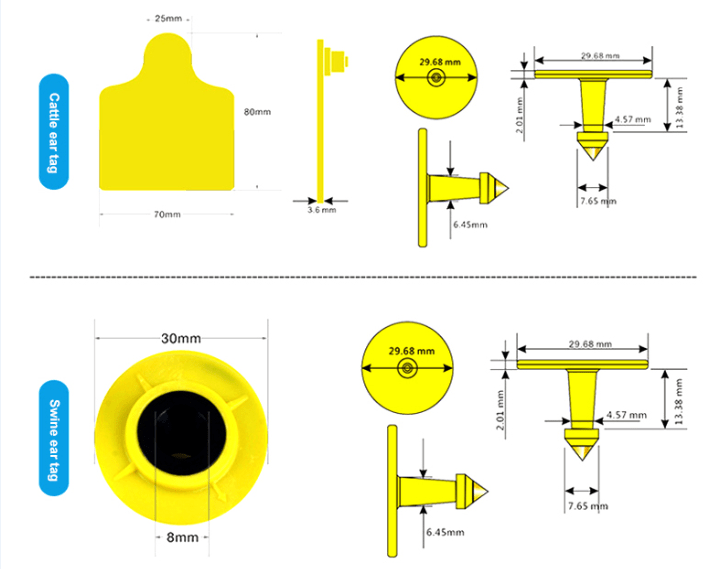
Merking is belangrik vir vee om hulle te identifiseer en te monitor. Dus, dit is belangrik om etikette te kies wat die doel oplos sonder enige kompleksiteit. Daar is baie soorte etikette in die mark beskikbaar. Jy moet ondersoek en ontleed watter soort etikette die beste by jou vereiste en begroting sal pas en dan die aankoop doen.
Wat is 'n koei-oorring?
'n Beesoorring is 'n plastiek- of metaalvoorwerp wat 'n identifikasienommer daarop dra en in die ore van 'n dier geplaas word. Die nuwe elektroniese identifikasieplaatjie (EID) gebruik radiofrekwensie-identifikasietoestel (RFID) tegnologie vir doeltreffender veebestuur. Hierdie elektroniese etikette gebruik die EID-nommer of die bestuursnommer op die knoppie wat agter in die dier se oor geplaas word. Die inligting op die etiket word gelees en gestoor met behulp van radiogolwe.
Hoekom gebruik boere koei-oorbelle?
Boere en veeprodusente vind dit moeilik om die aktiwiteite van hul lewende voorrade op te spoor en te monitor, want die proses is duur en duur.. Daarom, hulle sit etikette op hul diere om hulle te help om die voorraad maklik te identifiseer en te monitor. Die etikette hou ook hul vee se prestasie dop en monitor hul gesondheid. Hierdie rekords verseker dat dit korrek gevoer word, inenting en beweging van diere op die plaas. En, help ook boere om betyds en korrekte besluite oor die verkoop van die beeste te neem as dit nie meer op die plaas benodig word nie.
Jy kan onderskei tussen 'n goeie en slegte koei-oorring op grond van die volgende kenmerke.

1. Grootte – Die koei-oorring word op die dier se oor geplaas. Dus, dit moet groot genoeg wees om selfs op 'n afstand sigbaar te wees en nie te groot om ongemak vir die dier te veroorsaak nie. Jy moet die identifikasienommers behoorlik op die etiket kan skryf sodat dit duidelik en leesbaar is. Nommers en strepieskode moet die volle grootte van die vroulike merker dek, vertrek 2 mm kantlyn aan alle kante.
2. Maklik om toe te pas – ’n Goeie etiket is maklik om aan te wend en is nie baie kompleks om te gebruik en in stand te hou nie.
3. Materiaal wat vir die etiket gebruik word – Metaalplaatjies word geassosieer met meer skade aan die ore as die poliuretaan (PU) etikette. Daar is hoër voorkoms van bloeding en infeksie by die merkpunt wanneer 'n metaalplaatjie gebruik word. 'n Goeie etiket moet gemaak word van eter-graad termoplastiese poliuretaan elastomeer materiaal wat bestand moet wees teen ultraviolet lig, hoë en lae temperatuur, en moet peuterbestand wees.
4. Skeurweerstand – ’n Goeie etiket moet nie uitval of onleesbaar word wanneer dit met vuiligheid of modder bedek is nie. Die elektroniese etikette is skeurbestand en bly vir hul leeftyd aan die dier vas.
5. Manlike en vroulike deel – 'n Goeie etiket moet die manlike en vroulike deel hê. Die manlike deel is die visuele deel wat ideaal rondom is 27 mm in deursnee en het 'n metaalpunt. Die vroulike deel is die knoppie met 'n nou kop.
6. Druk op etiket – 'n Goeie etiket kom met 'n donker nommerdruk, leesbaar genoeg van 'n afstand af. Die afdruk moet so wees dat dit nie oor die leeftyd van die merker oplos nie.
7. ISO gesertifiseer – 'n Goeie etiket moet ISO11784/11785 gesertifiseer wees met behoorlike dokumentasie van die vervaardiging en toepassing daarvan.
RFIDHY verskaf ISO-gesertifiseerde koei-oorbelle wat aan die industriestandaarde voldoen. Die etikette kom in verskillende frekwensies vanaf 134.2KHz, 125KHz tot so laag as 860 MHz en 960MHz. Hierdie waterdigte en skokbestande RFID-etikette is ontwerp om die tegnologie doeltreffend en moeitevry te implementeer. Met 'n 100% prestasie waarborg, RFIDHY se koei-oorbelle hou vir die leeftyd van die dier. Die elektriese dele van die RFIDHY Cow-oorbelle is bedek met TPU-materiaal wat ook gerieflik en sterk is in die moeilike omgewing. RFIDY gee u die voordeel dat u die ID-nommers volgens u vereiste kies. U kan ook u kleur en die inhoud wat u op die etikette wil druk, kies. Hierdie ISO-11784/11785-gesertifiseerde etikette het 'n waarborg van drie jaar. Hierdie etikette word aanbeveel vir veebestuur, Vee dop, Troeteldier- en laboratoriumidentifikasie, Diereteling, Plant, en voedselveiligheidsbestuur.
Hoe word 'n koei-oorring op die dier aangebring?

'n Koei-oorring dra die vyftien-syfer unieke Diere-identifikasienommer (AIN) saam met enkele ander besonderhede, soos eiendomsidentifikasienommer. Die AIN bestaan uit 'n 3-syfer-ondernemingskode en 'n individuele nommer van 12 individuele diere. Dit kan met die hand of deur 'n koei-oorringtoediener aangewend word. 'N Dier kan op een oor of albei gemerk word, afhangende van die doel van die etikettering. Die knoppie soos die RFID-skyfie word aan die oor vasgemaak in 'n proses soortgelyk aan die deurboor van die menslike oor. 'N ID-leser word gebruik om die data van hierdie etikette te skandeer en te versamel, wat dan op 'n rekenaar afgelaai en gestoor word. Hierdie proses verminder die kans op foute en hou al die data met betrekking tot 'n dier bymekaar.






